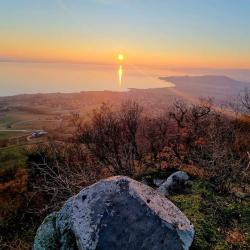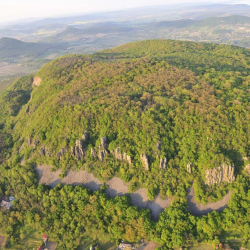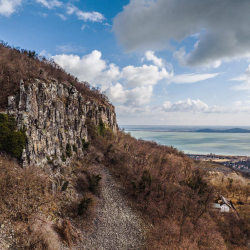
8261 Badacsonytomaj-Badacsony, Park u. 20. •
+36 87 531 013 •
badacsonytomaj@tourinform.hu
Badacsony

The Tapolca Basin was once a 'playground for giants', and the volcanic formations were their playthings; Badacsony is a remnant of this mythological age. The Badacsony is also regarded as the prince of the surrounding volcanic mountains, as it is the most massive and highest volcanic formation in the Tapolca basin, and the heart of the wine region with its long history. The mountain is the home of interesting stories, and of course a rich history stretching from Neolithic times to the present day. In addition to tasting the justly famous Badacsony wines, it is worth getting to know the living and inanimate natural values and cultural history of Badacsony. Badacsony is home to many protected birds, including the blue pigeon, the Eurasian pigeon, the cormorant, the dawn bird and the grey partridge.
Emblematic buildings include the Róza Szegedy House, the Kisfaludy House and the Rodosto Tourist House. The harvest festivals have made the mountain famous far and wide. From its many viewpoints, hikers can admire magnificent views from the Tihany peninsula to Keszthely Bay.
Badacsony is a major volcanic formation of the Bakony-Balaton Volcanic Field. It was formed 3 450 000 years ago by phreatomagmatic activity in a terrestrial geographical environment. The original volcanic superstructure has eroded over time and today we see the degradation of the former lava lake. Between 1903 and 1964, the high quality rock was quarried on a large scale and used by industry in a number of fields. The mountain is home to a number of protected botanical rarities, such as agaricus and rock pine. The Badacsony is a treasure trove of bird species, with more than 100 species on the mountain's list of bird species observed so far. Eight of the 9 species of woodpecker occur on the mountain. For the Badacsony as a whole, we have to go back 6 000 years in time, to the Neolithic period, when man was already present, although he did not live here as a regular inhabitant. In the Bronze Age, however, the entire top of the mountain was already covered with vegetation. The Celts were the first to cultivate vines, and Lábdihegy was once a Celtic chiefdom. It was not until the 2nd century that the Romans settled in the area that vineyards were cultivated, and they have been cultivated almost continuously on the hill for 2400 years. The harvest festivals, which began in the second half of the 18th century, are famous. Many noblemen had estates on the hill, but there were also ecclesiastical and peasant estates, since the vineyards were not tied to the vineyard. After the Phylloxera there were significant changes, both in the varieties of grapes and in the methods of cultivation. After the phylloxera crisis, there were significant changes, both in terms of grape varieties and cultivation methods. Today, the fine wines made from the grapes ripening on the slopes of Badacsony have made this magnificent mountain one of the best and most visited wine regions in the country.




